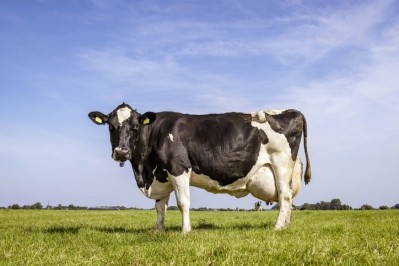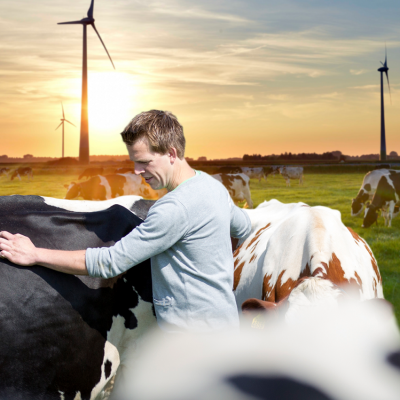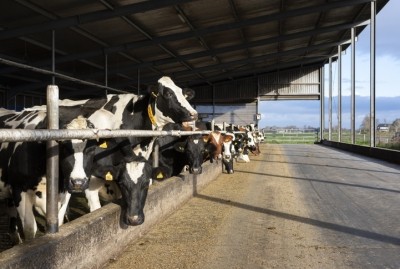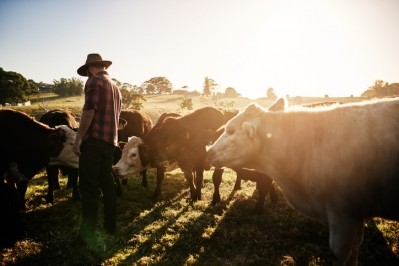DSM: Dutch dairy cattle trial shows efficacy of methane reducing feed additive
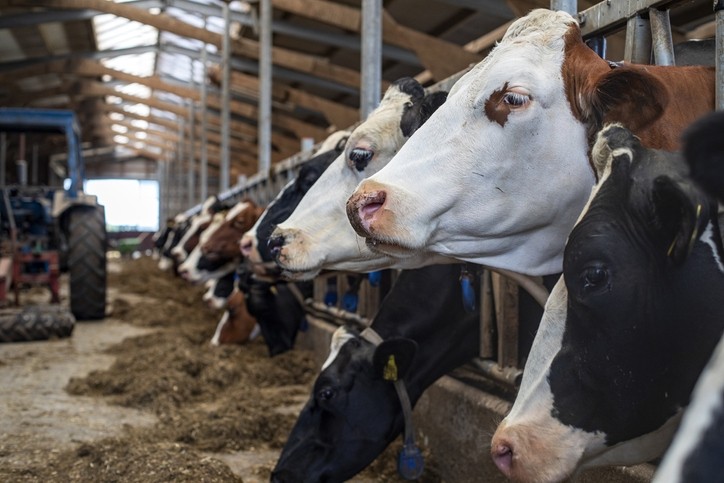
The emission reductions vary from 27% up to 40% of methane per cow, depending on the diets and the amount of methane inhibitor in the feed, found the study.
Methane emission from ruminants represents a significant portion of anthropogenic greenhouse gases and contributes to climate change.
The trial evaluating the methane inhibitor ran for three months; it was designed and executed by a consortium from across the Dutch dairy value chain, comprising of DSM, Wageningen University and Research (WUR), cooperative FrieslandCampina, as well as feed companies, Agrifirm, De Heus and ForFarmers.
The trial, which was supervised by a team of cattle nutrition experts at WUR and supported by the Dairy Campus Innovation Fund, aimed to deliver methane reduction results for three different ratios of grass silage and maize silage in dietary roughage, characteristic of feeds in different regions of the Netherlands. Two different dosages of Bovaer were used.
The study evaluated the different diets in 64 Holstein-Friesian cows in mid-lactation.
The trial data can be used to substantiate accreditation of Bovaer by the Carbon Footprint Monitor/Climate Module of the Dutch Kringloopwijzer, the annual nutrient cycling assessment program in the Netherlands. But the findings are applicable for the use of the additive in dairy cattle diets across Europe, said DSM.
Results
Methane was reduced by 27% when a low dose of Bovaer (60 mg/kg DM) was supplemented to a diet without maize silage in the roughage. It was lowered by up to 35% when a low dose of Bovaer was supplemented to a diet containing 80% maize silage in roughage dry matter. With a medium dose of Bovaer (80 mg/kg DM), this percentage ranged from 29% to 40%, said the company.
“The results provide farmers with insights on the effects of applying Bovaer.
“Furthermore, they enable governments and inventory organizations to adequately account for enteric methane reductions and they can be used to help reward and recognize every individual farmer for their sustainability contributions.”
The expert view
Jan Dijkstra, associate professor in the animal nutrition group, WUR, who was involved in the research, weighed in on the trial results for us:
"We examined two levels of Bovaer: 60 and 80 ppm. The difference between these levels is rather small, and we expected, based on previous research, that the 80 ppm level would have a 4%-units stronger methane reducing effect, compared with 60 ppm. The actual difference between the two levels was reasonably close to expectation, a 3% stronger impact of 80 vs 60 ppm.
"Also, we know from previous work that more maize silage, at the expense of grass silage, should decrease methane emissions. In our trial, it did – the high maize silage level (80% in roughage; DM base) had 10% lower methane emissions than the 0% maize silage level. This confirms previous findings and indicates again that the reduction of maize silage in the diet of dairy cattle in the past five years or so in the Netherlands is detrimental to enteric methane emissions."
The lower inclusion rate of maize silage in dairy cattle rations is a result of changes in derogation rules in the Netherlands, he explained.
"The major aim [of the study] was to evaluate the interaction between Bovaer and diet. In other words, is Bovaer equally effective, whatever the diet? We hypothesised, based on the meta-analysis in 2018, that Bovaer would be less effective with the 0% maize silage diet (containing more fibre) than with the 80% maize silage diet (having more starch and less fibre). The results of the trial match these expectations. Bovaer is more effective in the high maize silage diet. I think this is really important, in order to achieve targeted reductions. In practice, farmers may decide that, with high grass silage diets, they use a greater dose of Bovaer, for example."
He added that the evaluation of additives, using a solid scientific approach, with an adequate number of animals and high quality methane measurement techniques, is always highly commendable.
"Doing such evaluations in different circumstances (in our case, different levels of maize silage spanning the full range encountered in practice in the Netherlands and several other countries) is relatively rare in literature. Yet depending on the mode of action, the efficacy of many additives may depend on the diet composition. As such, the experiment is a major step forward."
Market introduction
Earlier this week, we reported that DSM had teamed up with Fonterra to evaluate the efficacy of using Bovaer to reduce methane emissions in pasture-based dairy farming.
The feed additive is targeted for use in all ruminants; it was researched and developed over 10 years by DSM.
The company has filed for registration of the feed additive in various geographies, and it says that it continues to work with partners from the dairy and beef value chain across the globe to prepare for market introduction.
This article was updated on February 5, 2021 to accommodate the comments of Jan Dijkstra.
